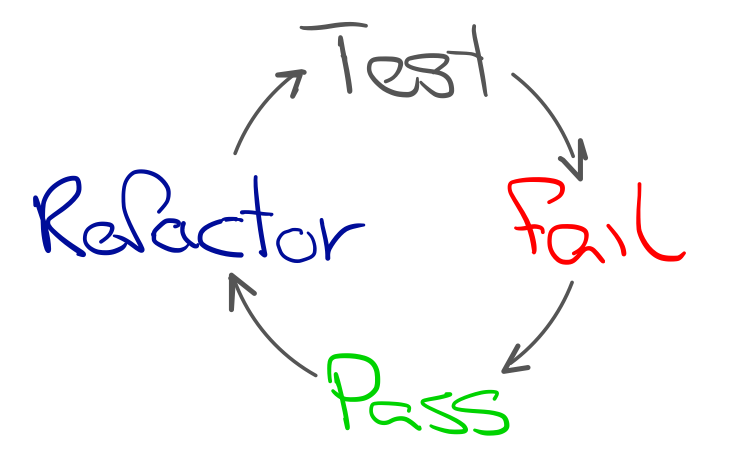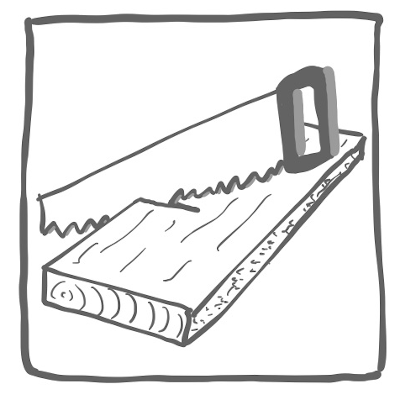The practice of Test Driven Development (TDD) has been around for quite a few years. It was popularized as part of eXtreme Programming 20 years ago. It has been our favourite way of working ever since, helping us to deliver multiple software products successfully. Though it’s simple to explain, it needs practice to master and to reap its benefits.
We notice that there are quite a few misconceptions about test driven development (TDD). This is partially due to the concept of TDD being more widely known - Gerald Weinberg’s Law of Raspberry Jam kicking in - the wider you spread it, the thinner it gets.
This is the first in a series of posts on how we do and teach test driven development.
The 5-minutes-to-the-coffee-machine explanation of TDD
We can explain TDD while walking to the coffee machine. The Test Driven Developent cycle consists of 4 steps that usually take seconds rather than minutes to go through:
- write a test
- see it fail
- make it pass
- refactor

Write a test
The first thing we do is: write a test. We write one test, which forces us to isolate the problem and make it concrete. We express it in code the details of the interface we design and the behaviour we expect.
See it fail
We run the test and watch the new test fail. As we did not write any code yet, we expect missing definitions and missing behaviour. Only the new test should fail. Are there any other failures? Fix them first. We also check if the feedback from the failure is helpful.
a red bar is progress!

Make it pass
Step by step we add code, run the test and see less (or different) failures. We strive for simplicity: we write just enough code just to make this test pass. Cheating and faking - like returning a constant value instead of a proper implementation - is allowed, or even recommended. It reminds us of the next test to write.
Hurray! – green bar! – let's party...

Refactor
…wait a minute with the party! There is a fourth step left: refactor.
Now that our tests are all green, we can safely clean up code, remove duplication, improve naming This is called refactoring - small, well-defined steps that improve the design of the code, without changing its behaviour.
🎉 Now we're done, let's party! 🎉
But what is it, really?
Some think TDD is mainly about going overboard writing unit tests; others think it is primarly about first writing tests; others think it is an all-or-nothing approach and get put off by fanatics stating it is the only true and professional way to write code.
TDD is a discipline of working - a way in which we approach our development work. It is a set of habits that help to keep on taking small steps towards our goals.
It reminds us that we continously take care of the code and refactor while everything is still fresh in our minds.
It forces us to think about the next step we are going to take, about how things should work; it forces us to express our intent precisely in code. Jim Shore call this a “series of validated hypothesis” - a test is a hypothesis, the code (in)validates it.
“I’m not a great programmer; I’m just a good programmer with great habits.”
– Kent Beck
Some effects
In TDD as Change Strategy, GeePaw Hill states “Microtest TDD is an effective change strategy because it dramatically improves our performance at comprehension, confirmation, and regression detection, all critical factors in handling change quickly & safely.”
TDD helps improving feedback latency in your development process. It provides faster, high quality feedback on design and code decisions. In her presentation “It’s All About Feedback”, Elisabeth Hendrickson elaborates on feedback latency in software development.
When doing TDD we find ourselves hardly using the debugger any more. The tests help us to pinpoint issues quite well. And we tend to start with writing a test first to reproduce a bug.
Working test driven does feel slow sometimes; sometimes we have a solution in our head, and writing test first, step by step feels like driving with your foot on the brake. We still find that working in this way is useful, as it forces us to think about our design. It provides rapid feedback about the brilliant solution in our head - which often turns out to be less brilliant than we initially thought… In the end it makes us go faster, because our code just works. With each green test, we are a step closer to our goal.
Is that all there is to it?
Practicing TDD is slightly more difficult than explaining it, and takes a bit of deliberate practice. It’s simple, but not easy. We suspect some developers get put off by this when trying out TDD: it takes some practice to become sufficiently fluent at it, so if you are new to it and try it only for a short time, it may be hard to judge its value.
TDD is not a recipe for success, it’s not a step-by-step method you can blindly follow that results in guaranteed high quality software. It is a way of working that helps us to make better design decisions; it provides a structure that enables us to take small steps, to continuously take care of our code, even if part of us can’t wait to start the next story. This way we grow a suite of fast, meaningful automated tests.
It is our default way of writing good code, doing incremental design and growing a suite of fast tests, because we’ve found that we hugely benefit from it in getting to results quickly, while writing code that works. It is not the only useful practice, but we see it as the basis for quality work and the foundation for doing CI/CD (continuous integration, continuous delivery) properly. It is a key practice in promoting small software changes to production quickly and with confidence in a sustainable, repeatable way
In touch with our work
For us software developers, TDD helps being continuously in touch with our ‘material’, like an artist making a painting who gets immediate feedback from the brush and the canvas.

A story from Rob:
When helping my father doing carpentry, I was struggling to cut a plank in half with a saw. My father made it look so easy. His saw went through wood like a knife cutting through butter. His cuts where clean and straight. I was sweating to get the saw through. Half way through, I was getting fatigue in my arm and my cuts where ugly, uneven. It was frustrating.
I remember my father kept saying: "Just let the saw do the work and it helps if you go back and forth in a straight line." When cutting a plank, his words still resonate in my head.
"Let the saw do the work", really means "don't put too much pressure on the saw". It will make for cleaner cuts and will prevent fatigue in your arm. Similarly, "Going back and forth in a straight line" helps the saw cut easier though the wood, prevent fatigue, and makes for cleaner cuts as well. The things he said were not practices, but rather principles and heuristics that make the process smoother and the end result better.
Like cutting a plank, TDD is deceptively simple to explain but it is hard to do well.
Heuristics and guidelines
Over the years of training and mentoring people, we have collected a number of heuristics and guidelines that help us to write, and explain how to write, tests that are clean, maintainable, and helpful. We are going to share these through a series posts the next few weeks. Keep an eye on this blog!
I want to learn more!
-
Go to the source. Kent Beck’s book Test Driven Development, By Example from 2002 is a good source to learn more.
-
Another book we often recommend is Growing Object Oriented Software, Guided by Tests, by Steve Freeman and Nat Pryce (2008). This book applies TDD in a broader way, not just unit testing but also acceptance testing.
-
Jim Shore did a series of Lunch & Learn sessions on TDD last year, which is a series of 21 videos where he shows all aspects of TDD - also highly recommended! Jim’s The Art of Agile Development book is a great resource on agile principles & practices, including Test Driven Development; see also the pre-release chapter on TDD from the upcoming second edition of the book.
-
Lasse Koskela wrote about applying TDD in a Java context in Test Driven - Practical TDD and Acceptance TDD for Java Developers (2008)
-
GeePaw Hill has written a lot of thoughtful posts on TDD. See for instance his video on Five Underplayed Premises Of TDD
-
Emily Bache recently published an article on InfoQ, on How to Spread Technical Practices Like TDD in an Organization. She has also collected a number of katas - short coding exercises to practice TDD.
-
Read more about the Law of Raspberry Jam and other insights about consulting in Gerald’s Weinberg’s Secrets of Consulting
Updated 01-07-2021: added The Art of Agile Development & Test Driven to further reading
